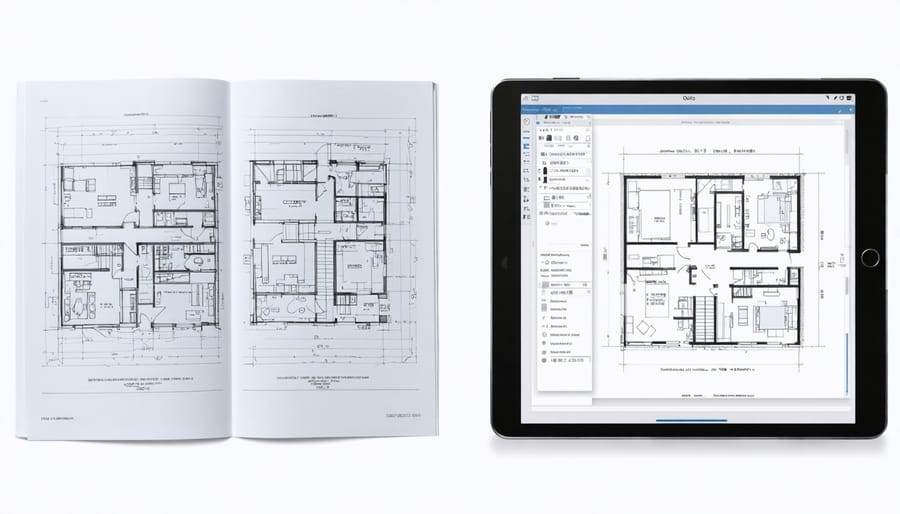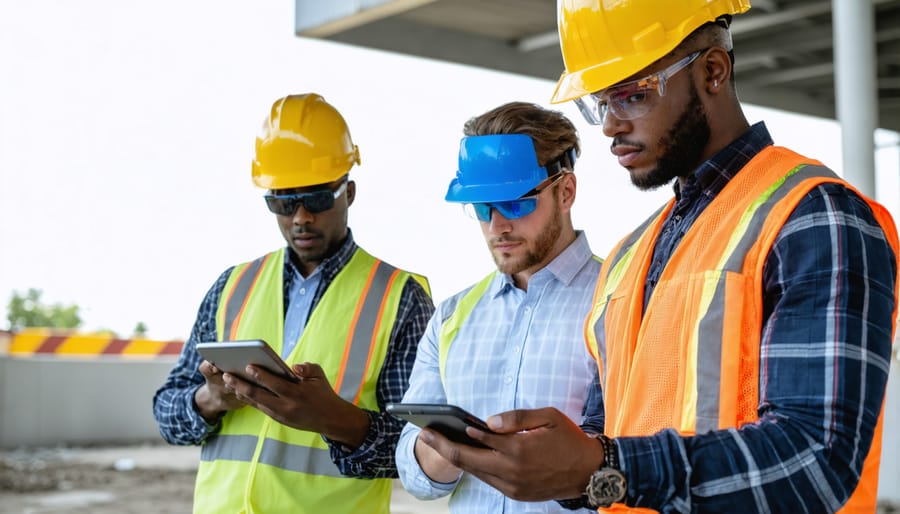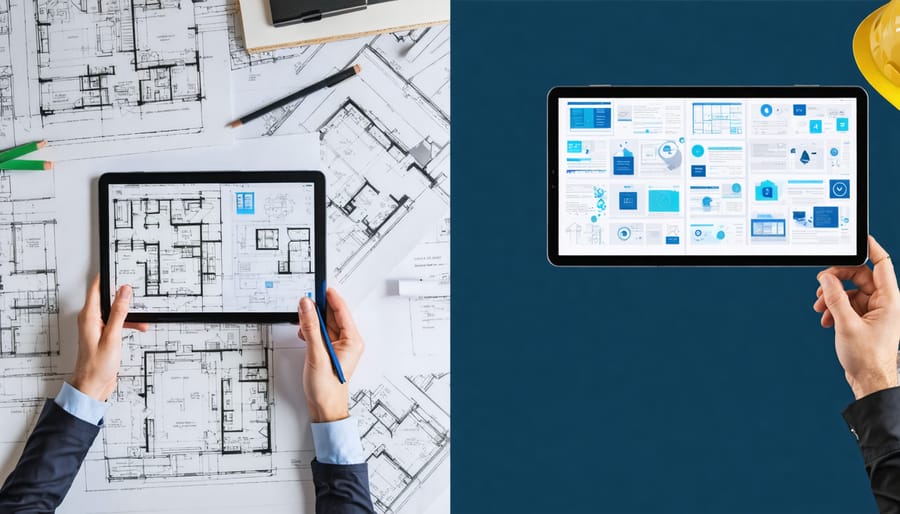Digital communication platforms have revolutionized how construction teams collaborate, driving unprecedented efficiency and transparency across projects. As digital transformation in construction accelerates, these platforms have become indispensable tools for managing complex workflows and diverse stakeholder interactions.
Modern construction projects generate thousands of daily communications—from RFIs and submittals to change orders and progress updates. Traditional methods of managing this information through email chains and paper documentation create significant risks: delayed responses, miscommunication, and lost information that can derail project timelines and budgets.
Purpose-built digital platforms eliminate these challenges by centralizing all project communications in a single, secure environment. They enable real-time collaboration between office and field teams, automate routine workflows, and maintain comprehensive audit trails of all interactions. For construction leaders seeking to enhance project delivery and team productivity, implementing these platforms isn’t just an operational upgrade—it’s a strategic imperative that directly impacts bottom-line results.
The Digital Revolution in Construction Communication
From Paper to Digital: The Communication Shift
The construction industry’s transition from paper-based communication to digital platforms represents a fundamental shift in how project teams collaborate and share information. Traditional methods, including physical blueprints, paper forms, and in-person meetings, while familiar, often led to delays, miscommunication, and document version control issues.
Digital communication platforms have revolutionized this landscape by enabling real-time information exchange, seamless document sharing, and instant updates across project stakeholders. Construction professionals can now access critical project data, drawings, and specifications from any location, significantly reducing response times and minimizing errors that were common with paper-based systems.
This evolution has particularly benefited large-scale construction projects, where multiple teams must coordinate effectively. Digital platforms have eliminated the need for physical document storage, reduced printing costs, and improved project transparency. The ability to track communications, decisions, and changes digitally has also strengthened accountability and created more reliable audit trails.
The adoption of digital communication tools has become increasingly crucial as construction projects grow more complex and teams become more geographically dispersed. This technological progression aligns with broader industry trends toward digital transformation and improved operational efficiency.

Real-Time Collaboration Benefits
Real-time collaboration features in digital communication platforms revolutionize how construction teams coordinate and execute projects. By implementing a comprehensive construction communication plan through these platforms, teams can achieve unprecedented levels of coordination and efficiency.
These platforms enable immediate decision-making through instant messaging, video conferencing, and collaborative document editing. When design changes occur or issues arise on-site, stakeholders can respond immediately, preventing costly delays and miscommunications. Project managers can coordinate with architects, engineers, and contractors simultaneously, ensuring all parties have access to the latest information and can contribute their expertise in real-time.
The ability to share and markup drawings, update project schedules, and resolve RFIs instantly has demonstrated significant impact on project timelines. According to recent industry studies, construction teams using real-time collaboration tools report up to 35% faster decision-making processes and a 25% reduction in project communication delays. This immediate responsiveness not only accelerates project progress but also helps maintain budget constraints and quality standards throughout the construction lifecycle.
Core Features of Modern Construction Communication Platforms
Document Management and Version Control
Modern digital communication platforms excel in document management and version control capabilities, offering construction teams robust solutions for handling project documentation. These systems maintain a centralized repository for all project files, from blueprints and specifications to contracts and change orders, ensuring teams always access the most current versions.
Version control features automatically track document revisions, maintaining a complete history of changes and enabling teams to review previous versions when needed. This eliminates confusion over which document version is current and prevents costly mistakes from outdated information. Each modification is timestamped and attributed to specific users, creating a clear audit trail for compliance and accountability.
Advanced platforms implement check-in/check-out systems, preventing simultaneous editing conflicts while allowing multiple team members to collaborate effectively. Document approval workflows can be customized to match organizational processes, with automatic notifications keeping stakeholders informed of pending reviews and approvals.
Cloud-based storage ensures documents remain accessible from any location while maintaining security through role-based access controls and encryption. This combination of accessibility and security is crucial for maintaining project momentum while protecting sensitive information.
Mobile Access and Field Updates
Modern digital communication platforms prioritize mobile accessibility, enabling construction teams to stay connected regardless of their location on or off the site. Through dedicated mobile apps and responsive web interfaces, team members can access project information, submit updates, and respond to critical communications using smartphones or tablets.
Real-time field updates have revolutionized how construction teams report progress and address issues. Site supervisors can instantly document work completion, safety concerns, or quality control matters by capturing photos, videos, and detailed notes directly through their mobile devices. This immediate documentation ensures that project stakeholders receive timely information and can make informed decisions without delay.
Mobile functionality extends beyond basic communication to include sophisticated features such as digital markup tools, GPS location tracking, and offline capabilities. Field workers can annotate drawings, verify measurements, and log materials even in areas with limited connectivity, with data automatically syncing once network access is restored.
The integration of mobile access with project management systems creates a seamless flow of information between office and field operations. This connectivity enables rapid response to RFIs, change orders, and daily reports, significantly reducing communication delays and potential misunderstandings that could impact project timelines.

BIM Integration and Visual Communication
Modern construction projects increasingly rely on 3D BIM modeling platforms to facilitate visual collaboration and streamline project communication. These sophisticated tools enable real-time model sharing, clash detection, and interactive markup capabilities across project teams, regardless of their physical location.
Leading platforms now offer cloud-based model viewers that allow stakeholders to access, review, and annotate complex 3D models through standard web browsers or mobile devices. This accessibility eliminates the need for specialized software installations while maintaining model integrity and version control.
Visual communication features typically include measurement tools, section cutting capabilities, and layer management systems that help teams focus on specific building components. Advanced platforms incorporate virtual reality (VR) and augmented reality (AR) functionalities, enabling immersive model exploration and on-site visualization of design elements.
Integration capabilities extend to document management systems, allowing teams to link relevant specifications, RFIs, and submittals directly to model elements. This connection between visual and documentary information creates a comprehensive project information ecosystem, reducing communication gaps and improving decision-making efficiency.
Real-time collaboration tools enable multiple users to conduct virtual walk-throughs, highlighting potential issues and documenting solutions within the shared model environment.

Implementation Success Stories
Large-Scale Commercial Project Case Study
In 2022, the Madison Square Tower project, a 65-story mixed-use development in downtown Chicago, successfully implemented an integrated digital communications platform that transformed their project delivery process. The $850 million project, managed by Turner Construction, faced significant challenges coordinating among 45 subcontractors and over 600 on-site personnel.
The project team deployed Procore’s enterprise platform, customized with specific modules for RFI management, document control, and real-time collaboration. Implementation began with a three-week training period, during which project managers and field supervisors received comprehensive platform orientation.
Key results included a 42% reduction in RFI response time, dropping from an average of 7.2 days to 4.2 days. Document version control issues, which previously caused an estimated $280,000 in rework costs, were virtually eliminated. The platform’s mobile functionality enabled field teams to access and update critical information in real-time, improving decision-making speed by an estimated 35%.
Perhaps most significantly, the platform’s analytics dashboard helped identify communication bottlenecks early, allowing the project team to maintain their aggressive 32-month schedule despite complex logistics and supply chain challenges. The project achieved substantial completion two weeks ahead of schedule, with stakeholders citing the digital platform as a crucial factor in this success.
The system’s audit trail functionality also proved invaluable during dispute resolution, reducing the average resolution time for change orders by 28%.
Infrastructure Project Communication Success
Digital communication platforms have revolutionized infrastructure project delivery by streamlining information flow and enhancing collaboration across diverse stakeholder groups. Recent industry studies indicate that projects utilizing integrated digital platforms experience a 25% reduction in communication-related delays and a 30% improvement in decision-making efficiency.
These platforms excel in managing complex infrastructure projects by providing real-time updates, centralized document management, and automated workflow processes. For instance, the construction of the Singapore Mass Rapid Transit Thomson Line demonstrated how digital platforms enabled seamless coordination among 50+ contractors and 200+ suppliers, resulting in a 15% reduction in project timeline.
Project teams benefit from enhanced visibility and accountability through features like automated progress tracking, instant notification systems, and digital audit trails. The ability to access project information remotely has proven particularly valuable for large-scale infrastructure initiatives spanning multiple locations and time zones.
Case studies from major highway and bridge construction projects reveal that digital platforms reduce documentation errors by up to 90% and cut response times for technical queries by 60%. These improvements directly contribute to better risk management and fewer costly rework instances.
The integration of mobile capabilities allows field teams to report issues, submit RFIs, and access critical documentation instantly, fostering better alignment between office and site operations. This real-time connectivity has become instrumental in maintaining project momentum and ensuring quality standards across infrastructure developments.
Overcoming Implementation Challenges
Training and User Adoption Strategies
Successful implementation of digital communication platforms requires a strategic approach to training and user adoption. Begin with a comprehensive needs assessment to understand your team’s current technological proficiency and identify potential resistance points. This information will help tailor training programs to address specific challenges and knowledge gaps.
Establish a phased training approach, starting with platform champions who can later support their peers. These champions should receive advanced training and act as go-to resources for their colleagues. Schedule structured training sessions in small groups, focusing on practical, hands-on exercises that mirror real project scenarios.
Create detailed documentation, including quick-reference guides and video tutorials, making them easily accessible through a central knowledge base. Consider different learning styles by offering multiple training formats, such as live demonstrations, self-paced modules, and interactive workshops.
Set clear expectations for platform usage and establish measurable adoption metrics. Monitor user engagement and collect feedback regularly to identify areas requiring additional support. Implement a reward system that recognizes team members who effectively utilize the platform and contribute to its successful adoption.
Address resistance to change by clearly communicating the benefits and ROI of the new system. Share success stories and positive outcomes from early adopters to build confidence and enthusiasm among team members. Provide ongoing support through help desk services and regular check-ins to ensure sustained adoption and optimal platform utilization.
Security and Data Protection Measures
In today’s digital construction environment, robust security measures are paramount for protecting sensitive project data and communications. Leading digital platforms implement multiple layers of security, including end-to-end encryption, multi-factor authentication, and role-based access controls to safeguard project information.
Data protection starts with secure user authentication protocols and extends to comprehensive audit trails that track all system activities. These measures ensure accountability while enabling data analysis in construction projects without compromising security.
Industry-standard encryption protocols (SSL/TLS) protect data both in transit and at rest, while regular security updates and patches address emerging threats. Leading platforms maintain compliance with international data protection regulations, including GDPR and regional construction industry standards.
Best practices for platform security include:
– Regular security assessments and penetration testing
– Automated backup systems with geo-redundant storage
– Strict vendor access controls and monitoring
– Clear data retention and disposal policies
– Regular staff training on security protocols
Organizations should establish internal security policies that complement platform security features, including password management protocols, device security requirements, and incident response procedures. This comprehensive approach ensures that sensitive project information remains protected while maintaining efficient communication and collaboration across the construction team.
Digital communication platforms have fundamentally transformed the construction industry, enabling unprecedented levels of collaboration, efficiency, and project oversight. As demonstrated throughout this analysis, these platforms have become indispensable tools for modern construction projects, facilitating real-time information sharing, streamlined workflows, and improved decision-making processes.
The future outlook for digital construction communication platforms appears increasingly promising. Industry experts predict further integration with emerging technologies such as artificial intelligence, machine learning, and IoT sensors, creating even more sophisticated project management ecosystems. These advancements will likely enable predictive analytics, automated reporting, and enhanced visualization capabilities.
However, success with these platforms ultimately depends on proper implementation, user adoption, and organizational commitment. Companies that invest in comprehensive training programs and establish clear communication protocols typically achieve the best results. As the construction industry continues its digital transformation, organizations that embrace these technologies will gain significant competitive advantages.
Looking ahead, we can expect to see more specialized features tailored to specific construction disciplines, improved mobile capabilities, and stronger integration with other construction management tools. The emphasis will likely remain on creating more intuitive, unified platforms that reduce complexity while increasing functionality and security.
For construction professionals, staying informed about these technological developments and maintaining adaptability will be crucial for future success in an increasingly digital construction landscape.

